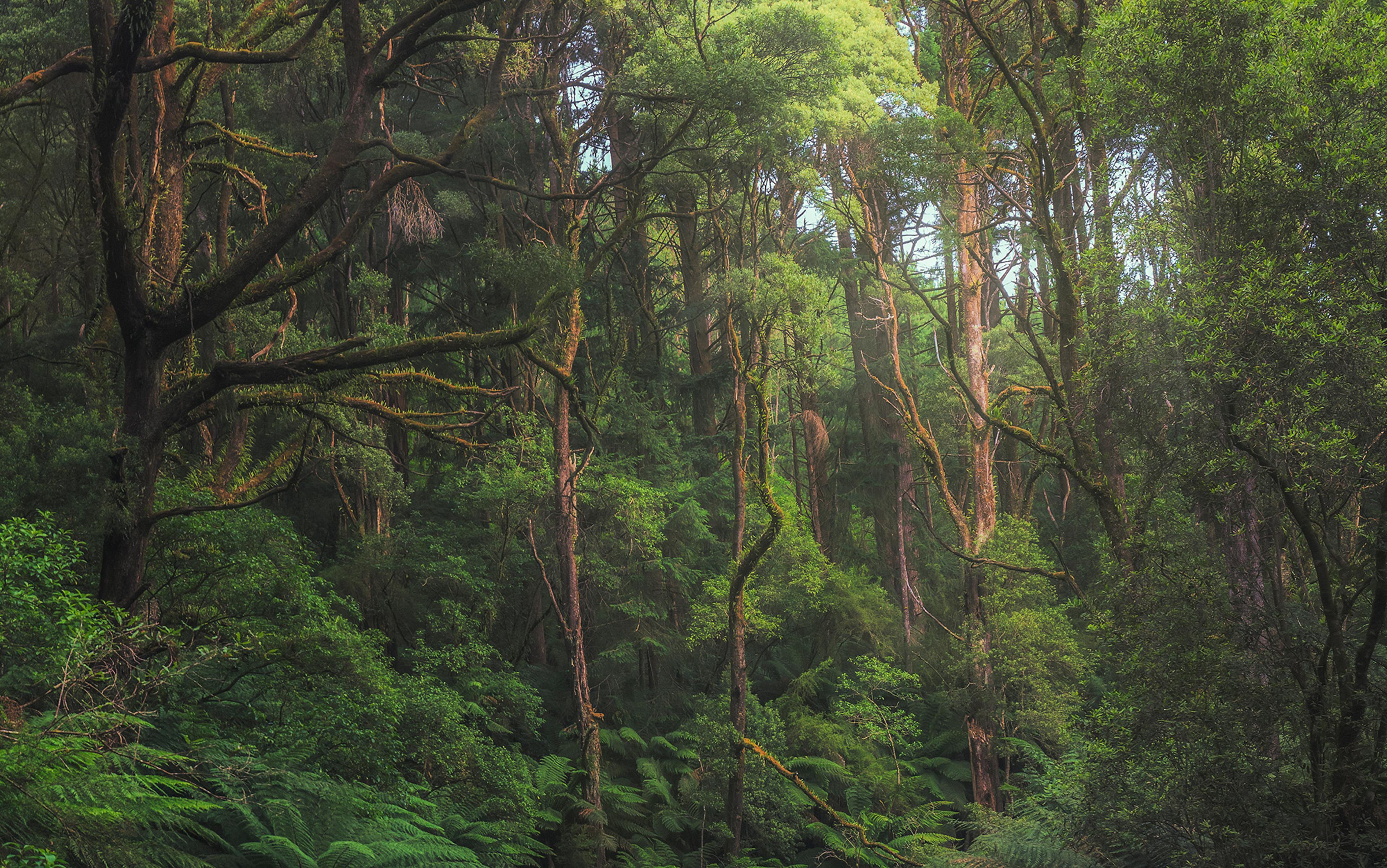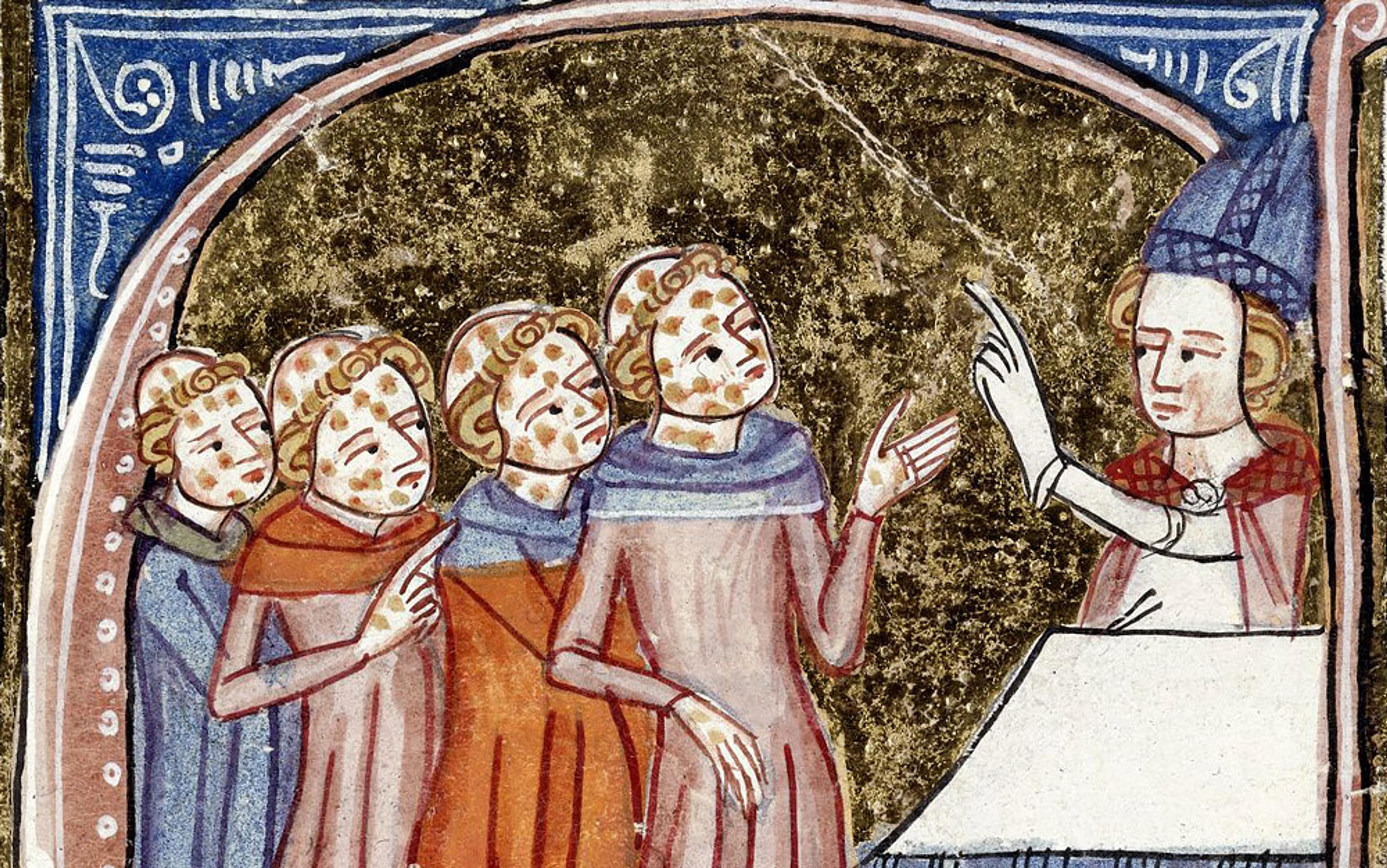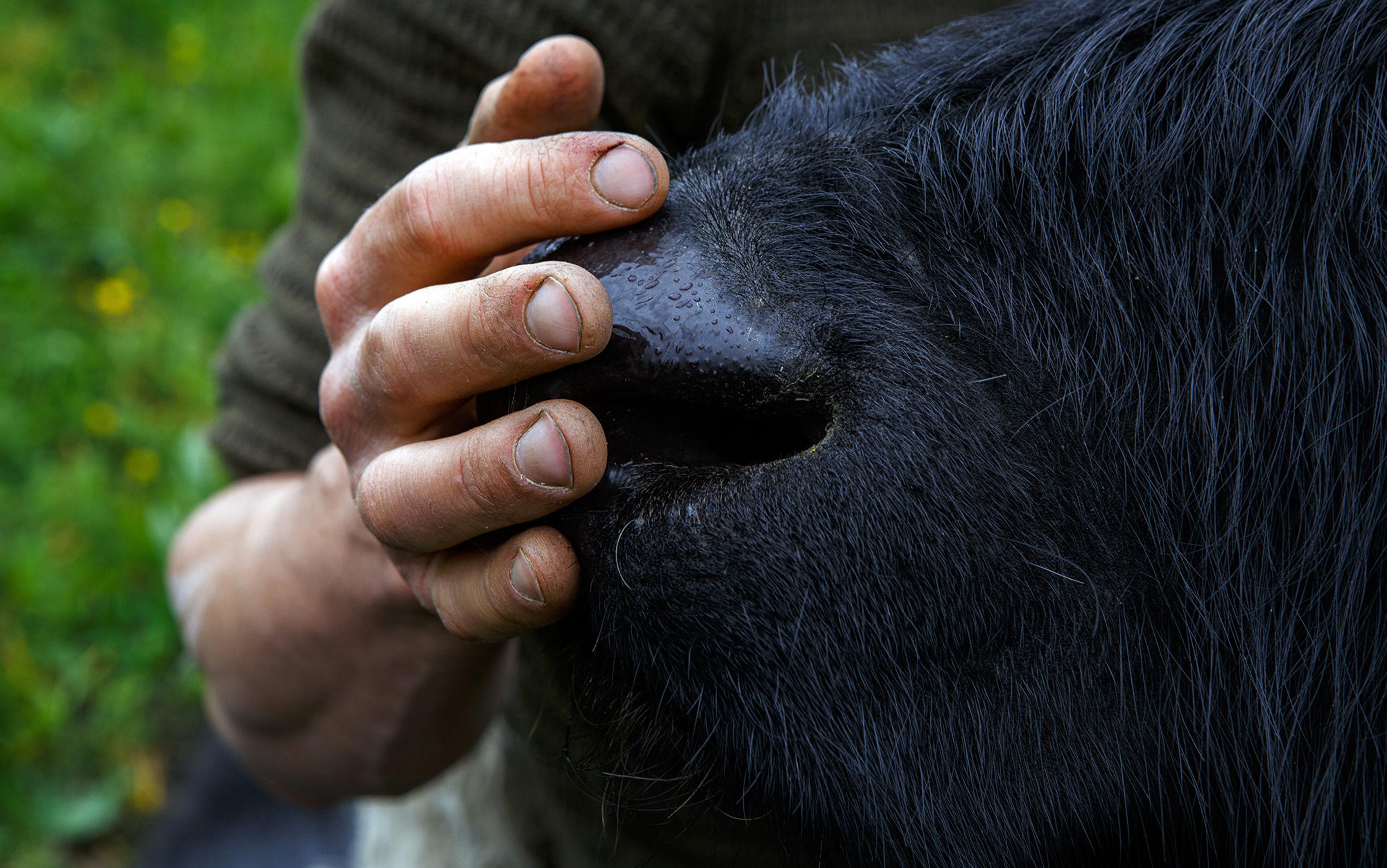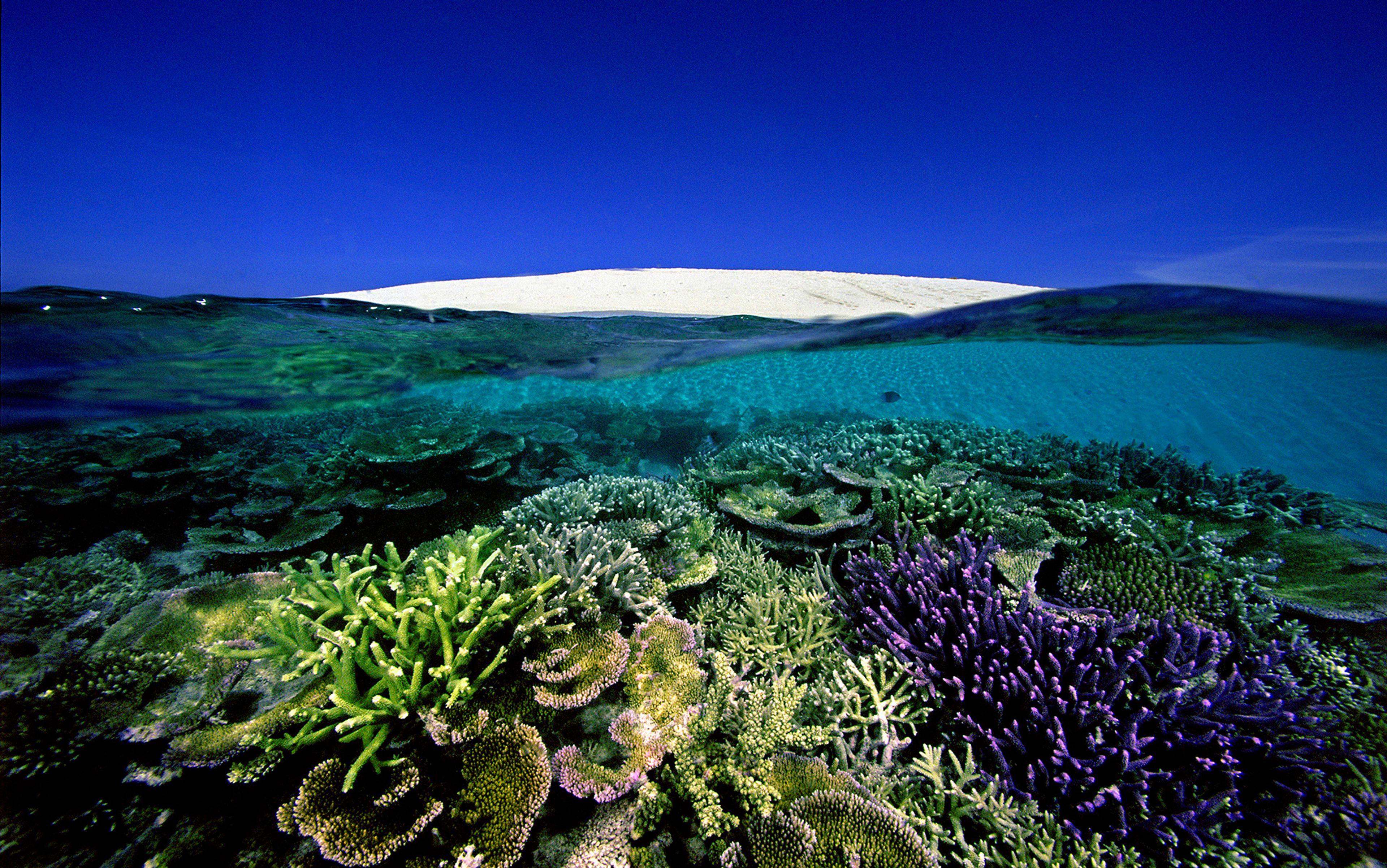A few degrees north of the equator, in the hot, humid rainforests of Ghana, two groups of farmers are vying for dominance over the world’s most productive chocolate-growing region. Chocolate is made from cocoa beans found in the large, rugby-ball-shaped pods of cocoa trees. People have been planting these trees in Ghana since the late 19th century and the crop is a mainstay of the country’s economy. But the trees have recently proved an inviting target for a wily group of rival agriculturalists, whose practices threaten the long-term survival of cocoa in Ghana. The trouble is, these competitors aren’t humans. They’re ants.
Ants have been farming for millions of years longer than humans. These particular ants herd mealybugs — small, sap-sucking insects that look like woodlice dipped in flour. The ants shepherd and protect the mealybugs so they can ‘milk’ the sugary nutritious fluids in their waste. The bugs used to drink primarily from local rainforest trees, but when humans started clearing the forest to make way for cocoa, the ants adapted, by driving their livestock into the fresh cocoa pastures.
This strategy shift entangled the cocoa trees in a web of pests and pestilence. When mealybugs drink from trees, they inject them with a pathogen called cacao swollen shoot virus (CSSV). In local rainforest trees, the effects of CSSV are mild, but cocoa — a newcomer to these forests — hasn’t had a chance to evolve countermeasures. As a result, the virus pummels the trees, swelling their shoots and roots well beyond their usual size while draining the colour from their leaves. Before long, often only a few years, the trees die.
The trees’ woes don’t end there, for these ants are builders as well as farmers. They strip cocoa pods to build tents for themselves and their mealybugs, protecting them from predators and pesticides. But the pods don’t have to be fresh. The ants are happy to harvest building materials from pods that have blackened with rot, thanks to two funguslike parasites — Phytophthora megakarya and Phytophthora palmivora. As they do so, they move spores from the parasites into uninfected trees, spreading black-pod disease in their wake.
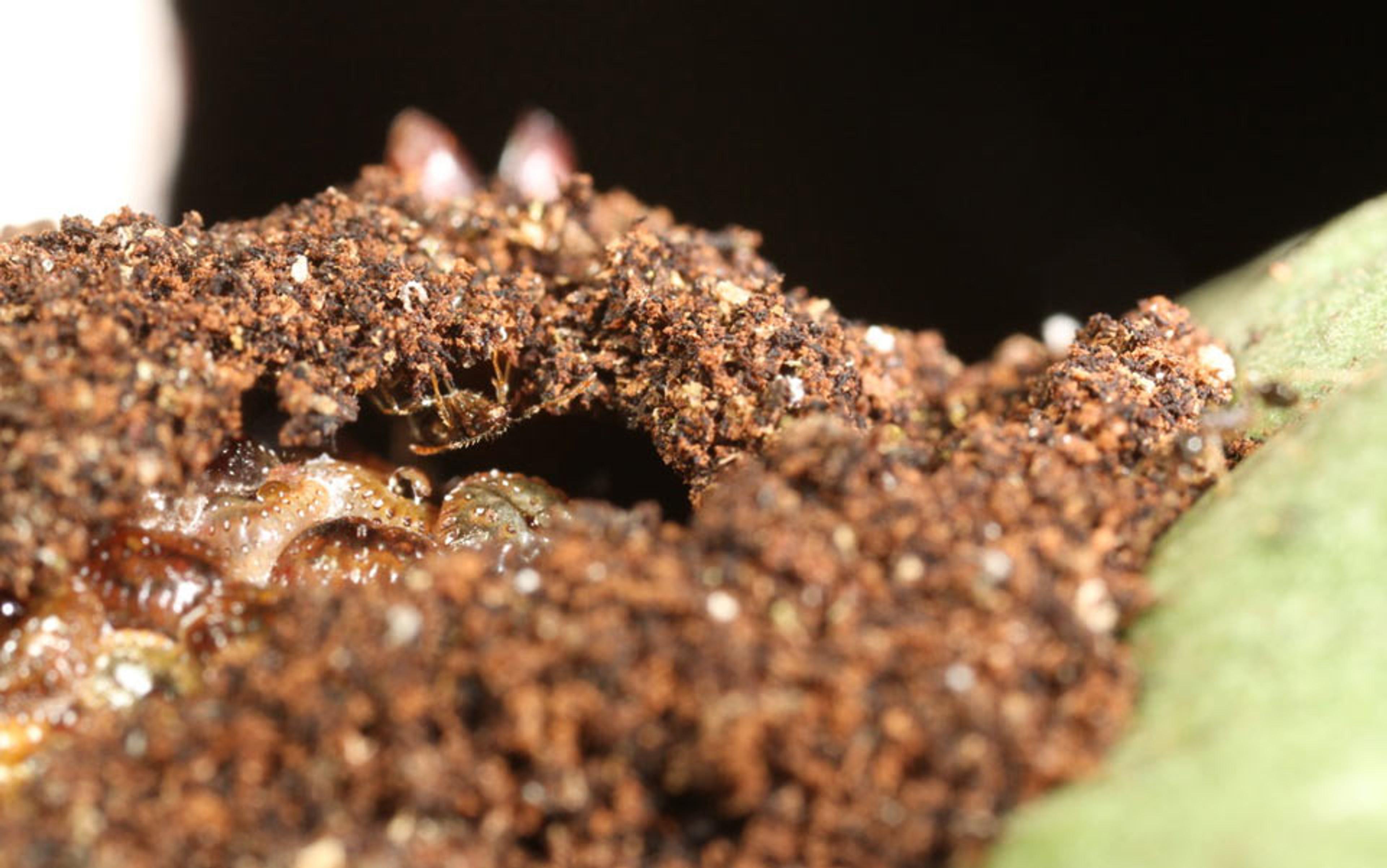
A ‘tent’ of soil containing the Phythophthora pathogen arches over a colony of plant-feeding bugs on the cocoa plant.
These parasites and viruses make for a dangerous mix. Just as HIV makes humans more susceptible to other infections, CSSV reduces pressure inside a tree, making it easier for Phytophthora to infiltrate its tissues and create a permanent reservoir of infection. Even when the diseased pods are cleared and the ants and bugs are removed, Phytophthora can still trigger fresh bouts of black pod from within the tree.
Thanks to ants, the cocoa trees are now vulnerable to parasites from three separate branches on the tree of life. It’s not easy for contemporary scientists to piece together these deadly ecologies. The details of this story are the arcana of natural history, scattered through old or obscure corners of the scientific literature and only fully assembled in the heads of a few knowledgeable scientists. One of those scientists is David Hughes, an ant-loving evolutionary biologist from Pennsylvania State University. I recently met him for lunch at a London pub, where he told me, in a deep Irish brogue, all about ants and parasites. ‘Ants are as wonderful and advanced as us,’ he said. ‘These are two societies fighting over the same plant — two households, both alike in dignity.’
Hughes recently visited Ghana to do fieldwork on ants, and couldn’t help but notice the signatures of this peculiar ant-driven web of contagion. He saw cocoa trees planted messily among rainforest natives, and blackened pods discarded on the humid floor, left to seed the soil with Phytophthora spores. Meanwhile, white mealybugs were sucking from the trees, with trails of ants patrolling up and down alongside them. ‘When you go to a tropical rainforest, you don’t see such things,’ Hughes told me.
Hughes is looking for ways to stop this entourage of disease from further ruining the fortunes of Ghana’s human farmers. And his efforts have opened his eyes to an even larger problem: the woeful neglect of plant diseases, by biomedical scientists and funding agencies alike. Laboratories bustle with research on malaria, flu, HIV, Ebola and other pathogens that destroy the human body, but there isn’t much research into those that target the plants we depend upon. If anything, investment is decreasing. ‘Our lab is half the number it used to be,’ said Amy Rossman, who studies plant diseases at the United States Department of Agriculture. ‘I think the same thing is happening worldwide.’ That could be a costly mistake, because plant pathogens are some of the most destructive plagues in the world. And it’s not just cash crops in the crosshairs; plant pathogens can also rot staple foods such as rice, wheat and cassava.
‘We’re set up for catastrophe, and we’re not talking about it,’ Hughes told me. He blames our urbanised culture. With so much time spent away from the natural world, and so many steps between our farms and our plates, we have lost a tangible connection with what we eat. ‘We live in a land of milk and honey. We’re so divorced from our food that we’re not even knowledgeable enough to be scared about the problems in getting it. We’re not thinking about the next AIDS of plants.’
The word ‘parasite’ comes from the Greek for ‘person who eats at someone else’s table’. It’s a fitting etymology, given that we lose 40 per cent of the plants destined for our dinner tables to parasites — including viruses, bacteria, fungi, worms and insects.
The fungi alone are capable of catastrophic damage. Writing in Nature last year, the Imperial College epidemiologist Matthew Fisher calculated that if severe fungal epidemics simultaneously struck the five most important crops — rice, maize, wheat, potatoes and soybean — they would leave enough food to feed only 39 per cent of the world’s population. The chance that all five crops would be hit at once is unlikely, but even now these diseases consume enough food to feed 9 per cent of the globe. And the problem is hardly confined to food production; history tells us that when pestilence brings famine, then war and death follow shortly behind. Plant diseases offer all four horsemen rolled into one.
Consider the positively apocalyptic effects of Phytophthora infestans, or potato blight, as it’s commonly known. P infestans, whose astonishingly accurate Latin name means ‘infectious plant destroyer’, kills potatoes and tomatoes, while its relatives — there are more than one hundred species of Phytophthora — attack oak trees, rhododendrons, soybeans, cocoa, and more. They look like fungi, grow like fungi, succumb to anti-fungal poisons, and are studied by mycologists, but their DNA reveals them to be close relatives of brown algae and kelp.
Mycologists suspect that P infestans originally evolved to attack the wild potatoes of Central America. When Europeans brought the potato to their farmlands in the 16th century, they left the staple crop’s ancient enemy behind. But two centuries later, the boom in international transport allowed it to catch up. The parasite hopped a ship and made landfall in continental Europe, where it wreaked havoc on potato farms. And its work there was just a warm-up act, compared with the devastation it visited on Ireland — a country whose poor were wholly dependent upon potatoes. From 1845 to 1847, the plant destroyer turned potato fields to rotting mush, starving more than a million people. As a result, Ireland’s economy tanked, tensions with England mounted, and the United States, Canada and Australia gained sizeable new populations of Irish migrants. In only a few years time, an alga in fungal clothing changed the fate of the English-speaking world.
It stays fixed in this death-grip while a capsule erupts through its head, ready to rain spores down upon other ants passing below
It also changed the course of science. When the potatoes started dying, people thought they were reacting to heavy rainfall, or some other change in the environment. They thought the strange mould growing upon them was merely decay setting in on the already dying tubers. It was the English mycologist Miles Joseph Berkeley who, in 1846, first suggested that the mould was the cause of the blight and not its consequence. That seems obvious now, but it was a revolutionary suggestion at a time when most people still believed that microbes were spontaneously generated from inanimate matter. Though ridiculed by his peers, Berkeley’s insight marked the ‘birth of plant pathology’, according to David Cooke, who studies P infestans at the James Hutton Institute in Dundee in Scotland.
P infestans is only one of the many plant pathogens that changed the world. Back in the 19th century, Britain’s drink of choice was coffee, and its colony Ceylon (now Sri Lanka) was the world’s greatest coffee producer. That all changed with the arrival of the East African coffee rust fungus, which found a ready-made feast among Ceylon’s dense, back-to-back plantations. The British government sent Harry Marshall Ward, another pioneering plant pathologist, to deal with the problem. He issued a now-familiar warning: planting crops in vast monocultures is an invitation for virulent epidemics. No one listened. Within two decades, the fungus had slashed Ceylon’s coffee production by 95 per cent, forcing the industry to relocate to Indonesia and the Americas. The crippled plantations were replaced by tea bushes, and tea displaced coffee as the quintessential British beverage.
If Marshall were around today, he would probably be disappointed that his advice still goes unheeded. We still tie the fortunes of entire regions to single staples. Around 90 per cent of the world’s calories come from just 15 types of crops, most of which are highly inbred monocultures planted over sprawling acreage. These monocultures skew the evolutionary arms race in favour of pathogens, and create the conditions wherein old threats can easily evolve into new virulent strains.
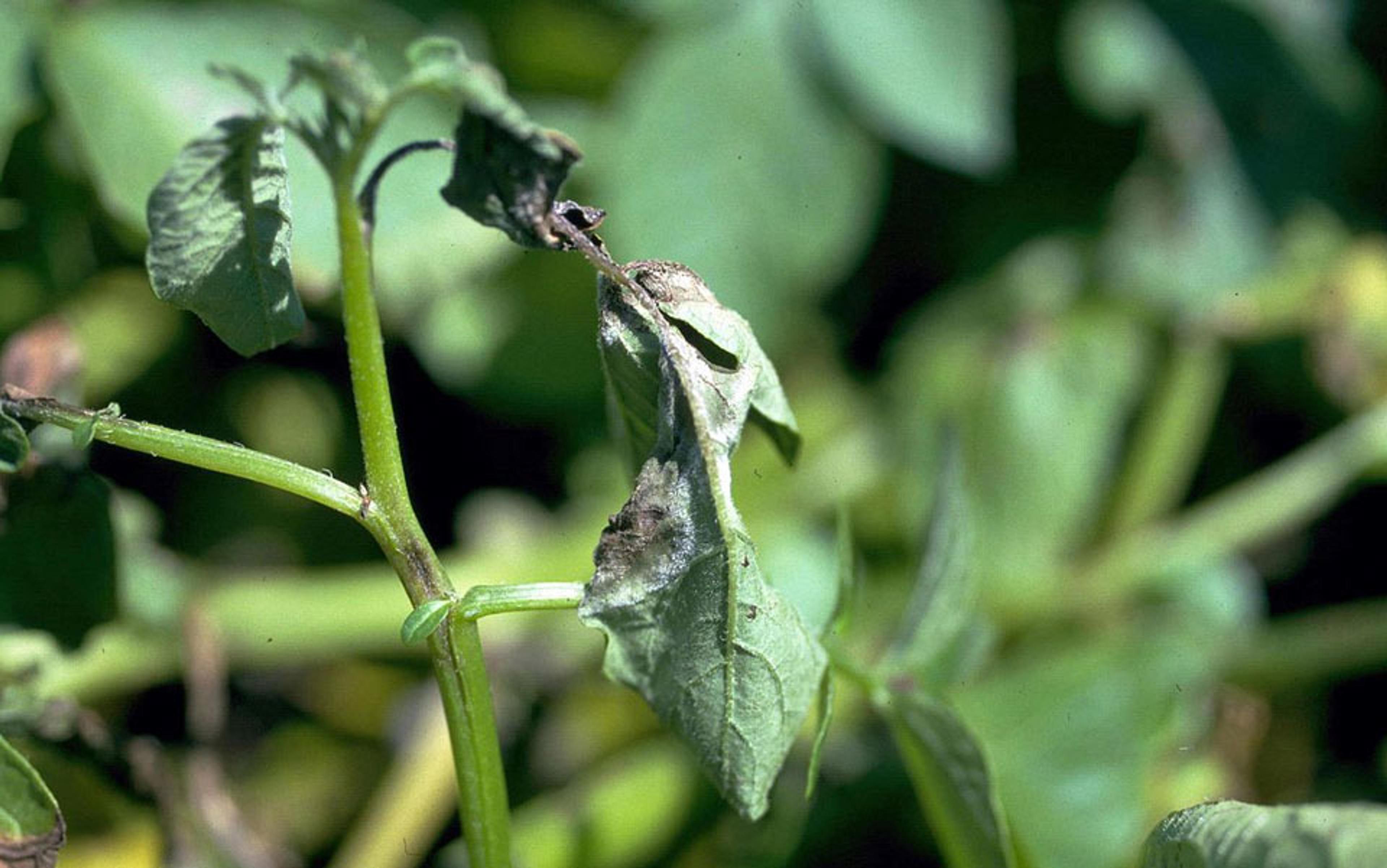
Phytophthora infestans or potato blight. Photo courtesy Wikimedia commons
P infestans is also changing. The strain behind the Irish potato famine is long extinct, but existing lineages still cause losses of $5 billion every year. Two of these strains recently met and exchanged their genetic material, creating a new strain called Blue-13 that has rapidly usurped all others in Western Europe. It is extremely aggressive, completely resistant to key fungicides, and can bypass potato defences that have been specifically bred to resist P infestans. ‘It has the perfect collection of traits that allow it to spread and be evolutionarily successful at the cost of the growers,’ said Cooke, who discovered it.
Will Blue-13 or something like it cause the next Irish potato famine? No one knows. The only certainty, according to Hughes, is that ‘we can always expect these diseases to get worse’. They will always catch up with escaped hosts, and they will always evolve around resistance. He added: ‘We can never expect them to get better.’
Hughes knows full well what plant diseases can do. ‘As an Irishman, I think a lot about people starving,’ he told me. Hughes grew up in a poor family from Dublin and, as a youth, had a penchant for getting into trouble. After being kicked out of school at the age of 15, he earned a living through odd jobs, from construction to cycle delivery. At one point, he worked on a pony farm, guiding tourists on pony-back into the hills of western Ireland to see the ghosts of the great famine, the rows of empty soil mounds where potatoes had rotted to mush. With so many people dead or emigrated, the land was never reclaimed. ‘You can still see the scars on the landscape 150 years later,’ he said.
In his free time, Hughes nursed a deep love of biology by watching David Attenborough documentaries and climbing into abandoned roofs to look for bird nests. ‘We lived in a concrete jungle,’ he told me. ‘We didn’t have nature but inside I was a naturalist.’ That was what drew him back into education. He enrolled at the University of Glasgow and, after another brief dropout (‘I was drinking too much’) became a graduate student at the University of Oxford.
At Oxford, Hughes fell in love with parasites. He was especially smitten by Ophiocordyceps unilateralis, the ‘zombie-ant fungus’. Once an ant becomes infected, the fungus not only consumes it from the inside out but also steers its behaviour, propelling it to a zone on the forest floor where the temperature and humidity are just right. Once the ant is in the right spot, the fungus erodes its jaw-opening muscles, forcing it to irreversibly bite down on a leaf. It stays fixed in this death-grip while a capsule erupts through its head, ready to rain spores down upon other ants passing below. Hughes saw parallels with the famine fields of his youth. Just as a quasi-fungus brought Ireland low, a true fungus can cripple an ant civilisation. ‘I became interested in how natural selection designed organisms to break societies,’ he told me.
Accidental introductions — whether on a tourist’s shoes, a garden centre’s plants, or a scientist’s samples — are the single biggest cause of new plant diseases
That was how he met Harry Evans. A British plant pathologist with shoulder-length hair, a thick moustache and a Liverpudlian accent, Evans is what colleagues cheerfully describe as ‘a character’. He did a lot of the seminal research on zombie-ant fungi; over the course of his career, he has collected samples of infected ants from around the world. Evans joined us in the pub for lunch, and he and Hughes began telling me about their partnership. ‘I wrote to him and we started working together,’ Hughes said. ‘He badgered me!’ Evans corrected. ‘I said I was going to Brazil and he was over the next day.’
The duo formed a quick camaraderie. They notched 102 days in the field together, collecting zombified ants in a world tour that encompassed Brazil, Ghana and Australia. But this was just a side project for Evans. Hughes is the ant guru of the pair, while Evans is more of a globe-trotting botanical fixer. For 40 years, he has worked for CABI (the Centre for Agricultural Bioscience International), a non-profit organisation dedicated to solving agricultural problems. He has travelled round the world, using his extensive knowledge of fungi to save diseased crops, while helping to avert ecological disasters.
After travelling with Evans, Hughes became infected by plant pathology, too. ‘Every time we walked out of a tropical forest, we’d walk into a farm and I’d get this masterclass in plant diseases,’ Hughes told me. ‘This happened for two years, and it eventually percolated into my slow-working brain.’ Their time in Ghana was especially instructive. Evans had been studying cocoa there since 1969. He was the one who showed that Phytophthora is carried into cocoa trees by ants, and infiltrates more easily thanks to CSSV. Hughes, with his knowledge of ants and his burgeoning interest in plant plagues, knew where he wanted to work.
The story of plant pathology is about connections between countries as well as organisms. It has all the hallmarks of an epic — voyages across oceans, chance meetings, dashing getaways and fateful reunions — and the history of cocoa is a perfect exemplar. The genes of modern cocoa strains tell us that the plant originated in the upper Amazon. Thanks to chemical traces in Mesoamerican pottery fragments, we know that people have been making drinks from fermented cocoa beans as far back as 1900BC. That practice was still going strong millennia later, when European explorers such as the Spanish Conquistador Hernán Cortés arrived in the New World in 1504. Enchanted by chocolate drinks, they soon started cultivating cocoa in their own territories.
In the mid-19th century, cocoa journeyed from Brazil to west Africa. It was introduced into Ghana in 1878, by a Ghanaian blacksmith named Tetteh Quarshie who worked on an island plantation off Ghana’s coast. Quarshie established a nursery, and started selling trees to local farmers. The industry was a slow-burner at first, but once it took off, Ghana would never be the same. In 1891, it exported its first, measly 80lb batch of cocoa; two decades later, it was the world’s largest cocoa exporter, shipping out 40,000 tons a year.
As cocoa farms intruded into the rainforests, new enemies emerged to greet them. In 1936, cocoa trees started dying of a mysterious affliction, characterised by swollen stems and diseased leaves. It took four years before a young British plant pathologist named Peter Posnette identified the cause: a new virus, later named CSSV. Others soon showed that mealybugs were spreading the disease. Farms fell into neglect, millions of trees became infected, and Ghana’s cocoa industry threatened to collapse.
It took serious work from Posnette, but Ghana’s cocoa plantations managed to avoid the fate of Ireland’s potato fields. At his newly formed cocoa research institute, Posnette and a team of researchers crossed existing cocoa varieties with newcomers brought in from the Upper Amazon, producing hybrids that not only grew more vigorously but tolerated CSSV. Over the next five decades, scientists at the institute — now the Cocoa Research Institute of Ghana (CRIG) — continued to develop more resistant and more productive hybrids.
Diseases don’t happen in a vacuum. They come from somewhere. They are spread by things. They interact with one other
These efforts helped Ghana’s faltering cocoa industry to hold on until 1984, when economic reforms lifted it out of a 20-year funk. ‘They revitalised the cocoa industry in Ghana, which is partly why Ghana is now one of the most stable of African countries,’ said Evans, who joined the CRIG team in 1969 to study black pod disease. ‘Science-based agriculture lifted Ghana to its current position,’ added Hughes. ‘It’s as good a message as any for how good public-funded science can be in bringing countries out of the poverty trap.’
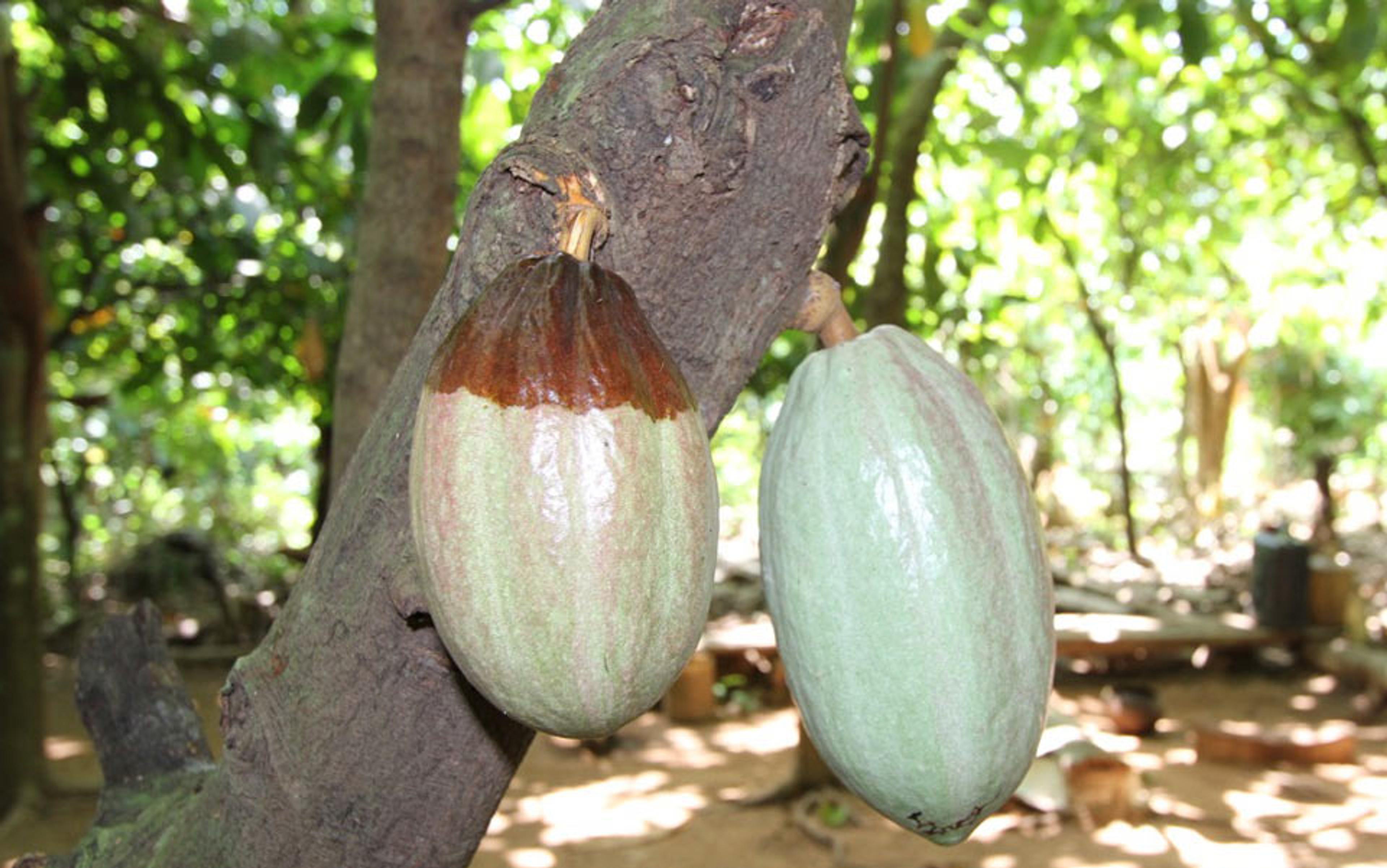
The Phythophthora-infected cocoa pod alongside a healthy (green) pod.
But the battle is not won. At best, it has reached a stalemate. CSSV and black pod disease still destroy much of Ghana’s cocoa and the solution, so far, has largely been to just plant more trees. ‘It’s a brute-force approach,’ says Hughes. ‘The cocoa industry has already factored in the losses. And that’s fine for multimillion dollar companies but, for the farmers, it’s the difference between sending a child to school or not.’
Across the ocean, more threats await. Two evocatively named fungal diseases — witches’ broom and frosty pod rot — pose potent threats to South America’s cocoa industry, and are potentially even more dangerous than their African counterparts. If they reach West Africa, they could devastate the industries of Ghana, the Ivory Coast, Nigeria and Cameroon, which together produce two-thirds of the world’s cocoa. ‘If these diseases get into Africa, you can forget cocoa,’ Evans said.
Frosty pod and witches’ broom have thus far been contained in South America because international cocoa stocks pass through quarantine centres in Reading in the UK or Montpellier in France. Incoming stocks can be held for two years to check for latent infections. But as potato blight and countless other diseases have shown, pathogens have a way of catching up to their hosts. Accidental introductions — whether on a tourist’s shoes, a garden centre’s plants, or a scientist’s samples — are the single biggest cause of new plant diseases. ‘Quarantines work to some extent but they only delay the inevitable,’ said Mary Catherine Aime, a plant pathologist from Purdue University in Indiana. ‘We just can’t control the way these things move across borders.’
There’s also the chilling possibility of a deliberate introduction, because a plant pathogen is a perfect bioweapon. Unlike human diseases, plant pathogens are easy to handle and safe for people — and they can quickly destabilise nations by destroying staple crops or important exports.
There are disturbing precedents for this. In 1989, witches’ broom disease hit the plantations of Brazil’s Bahia region — a last refuge for the country’s struggling cocoa industry. Long-standing estates crumpled, and the region’s production plummeted by 75 per cent. But how did the fragile fungal spores make it through the careful cordon that protected the area? Some suspect foul play. The disease had appeared suddenly, in the heart of the plantations as opposed to their fringes. There were claims that diseased branches were wired to trees. These rumours were apparently confirmed in 2006 when a man who worked for a government agency charged with eradicating witches’ broom actually confessed to deliberately introducing it into Bahia. The goal was to destabilise the local government, which was supported by cocoa barons. If true, the incident marks the first documented account of disease-based agroterrorism.
Every time we have a silver bullet, evolution jumps back at us with a response
Whether through accident or malice, we cannot count on plant diseases staying where they are. Their expansion is a matter of when, not if. We need to start preparing countermeasures. Education can help. ‘The majority of farmers in Ghana and most parts of Africa do very little or nothing at all to control diseases owing to lack of knowledge,’ wrote Emanuel Moses from Ghana’s Crops Research Institute in a 2010 book on plant pathology. Simple measures can help to control cocoa diseases, like planting trees more sparsely to improve air flow and reduce humidity, planting other crops to restrict the flow of pests, or removing blackened pods to stop ants from spreading spores to new trees. Several programmes exist to train farmers in the use of these techniques.
Other scientists are mining the cocoa genome for variants that are resistant to major pathogens. It’s the modern take on Posnette’s approach, but supercharged by the power of modern genetics. Still, resistant strains would only ever be a temporary solution. As P infestans has shown, pathogens will always evolve around resistance, as surely as they skip through quarantines. ‘I think breeding resistant varieties is a slow response to the amount of movement. We have to come up with something better,’ Aime said.
Hughes thinks the answer lies in ecology. Diseases don’t happen in a vacuum. They come from somewhere. They are spread by things. They interact with one other. Targeting a single cocoa pathogen is too reductionist — by studying all of them together, Hughes hopes to work out the weak link in their ensemble. Maybe it’s the ants? Working with Ghanaian scientists, Hughes has been experimenting with different ways of disrupting these insect farmers, through the killing of their queens, the use of insecticide or killer fungi, and even craft genetic tools that can switch off ants’ genes.
If any of these techniques works, farmers could keep the ants away from cocoa and prevent them from ferrying Phytophthora spores into the trees. Non-farming ants, and there are many around, would soon replace them. Without bodyguards or tents, the mealybugs would be vulnerable to parasites and pesticides, meaning less of them would survive to pump the trees with CSSV. ‘You want to shift the balance towards things that aren’t pathogenic to the plant,’ Hughes explained. ‘It’s a new approach to farming that’ll lead to changes over years. You’ll never have one solution that works in perpetuity. Every time we have a silver bullet, evolution jumps back at us with a response.’
As lunch was drawing to a close, Evans recounted the story of his greatest achievement — controlling rubber vine in Australia. Originally brought in to pretty up the coal mines with its pink flowers, this woody vine ran amok in Queensland. It exuded a poisonous latex, blocked animals from reaching waterways, and smothered eucalyptuses and other native plants. Neither fire nor pesticides could control it — but Evans was able to. He travelled to the vine’s centre of origin in Madagascar and brought back a rust fungus that specifically attacks rubber vine. In 1995, after years of testing, planes sprayed the fungus over the vine’s front lines… and completely halted its invasion. It was a rare success for Australia, a country known for its failed attempts at biological control.
‘The same bloody plant is in Brazil at the moment!’ said Evans, who cannot get funding to control it. ‘If you’re too successful, no one listens to you.’ It doesn’t help that the story is an obscure one. A different scientist might have milked a stream of high-profile publications from that kind of success, but Evans restricted himself to a few papers in backwater journals. He had more important things to do. ‘If I’d been cleverer, I’d have modelled the spread of the vine and got some papers in Nature and Science,’ he said. ‘But that wasn’t my brief. The brief was to control the spread of the invasive.’
Hughes toasted this do-first-publish-later approach, wishing more scientists shared it. ‘People are just interested in their CVs and keeping their labs running,’ he said. ‘We should assess people on whether they controlled problems, not where they publish. Did you control it or not? You did? Oh, well done.’
When ash dieback disease hit British trees in 2012, history repeated itself. ‘There were no taxonomists to identify the fungus,’ Evans said, ‘because we fired them all’
Indeed, scientists with Evans’s skills and mindset — the Yodas of plant pathology — are racing to extinction faster than the crops they study. Admittedly, ‘they’ve made a disastrous job of promoting themselves’, according to Hughes, but sexy modern sciences such as molecular biology have also drawn investment away from more traditional fields. In a recent audit, the British Society for Plant Pathology found that their subject is in free fall, relegated to a few lectures at a smattering of universities. Labs have halved in numbers, most scientists in the field are over 50, and new faces are rare. (The same is true across the pond.) ‘Molecular biology tells us what makes these pathogens tick, which is exciting,’ said Cooke. ‘But if we end up with a cadre of trained molecular biologists who can’t identify an oak tree, you have a problem.’
Hughes sees a deeper tragedy at play — the loss of a patient, contemplative approach to British natural history that allowed Charles Darwin and Alfred Russel Wallace to envision the theory of evolution by natural selection. ‘People like Harry [Evans] have spent 40 to 50 years working on groups of organisms, and know them deeply in the same way that Darwin or Wallace did,’ Hughes said. ‘We’re not replacing them, and that’s a lamentable shame.’
As the old guard retires sans apprentices, we lose the knowledge in their heads and we cripple our intellectual immune system. When Phytophthora ramorum started killing oak trees in the western US in the mid-1990s, it took a long time before anyone knew what it was, giving the disease a chance to establish a foothold. When ash dieback disease hit British trees in 2012, history repeated itself. ‘There were no taxonomists to identify the fungus,’ Evans said, ‘because we fired them all.’
The knowledge that remains is hardly accessible. ‘I just tweeted a CABI paper from 35 years ago on cocoa disease, and it costs $35 to access it,’ Hughes told me. And some of the field’s secrets, like Evans’s discovery that P megakarya can bounce back from inside cocoa trees, aren’t even in the literature — they’re noted in printed documents, hidden within the archives of organisations such as CABI or CRIG.
‘The world gets a sentinel system about spreading diseases,’ he explained. ‘We want to link everyone in the world growing food’
Hughes wants to democratise that hidden knowledge to give farmers a way of helping themselves. ‘Farming has always been a community affair but, in the modern era, we’ve lost those connections and knowledge is held by a few,’ he said. To rebuild these links, he teamed up with his Penn State colleague Marcel Salathé, a computer scientist who studies the spread of behaviour through social networks. Earlier this year, the duo launched plantvillage.com, an open-access website where people can ask each other for help with agricultural problems. Users vote the answers up and down, and accumulate points depending on how helpful they are. It’s like Quora for gardeners. ‘We’ll never invest in people like Harry again,’ Hughes said. ‘The second-best solution is to rely on the crowd.’
Many start-ups with world-changing ambitions have died on the vine, but five months in and the site is gently blooming. Every question that’s been posed, from requests for gardening tips to gripes about pests, has been answered by the small but active community. Admittedly, they are largely middle-class Americans and Europeans — a far cry from Ghanaian cocoa farmers. But Hughes is realistic. He is trying to build a thriving network first, so ‘we can be ready for three years’ time when Africa is mobile-ready’.
In his vision, people could snap photos of rotting leaves or blistering fruits, and receive diagnoses and tips from farmers and academics around the world. This has already started happening. ‘They get knowledge, and the world gets a sentinel system about spreading diseases,’ he explained. ‘We want to link everyone in the world growing food.’ We might never stop plant pathogens from criss-crossing the world, but our own webs of communication might be able to spot their advances early. We might never be able to replace the natural historians of the past, but we might be able to mobilise the village to compensate for the loss of its elders.
It’s an approach that could have been lifted from an ant’s playbook. Individual ants are hardly great strategists, but through their interactions, they can achieve incredible feats of swarm intelligence. Some successfully rear bugs, and build tents to defend them from threats. Others grow a delectable fungus by feeding it chopped up leaves, while killing off other moulds with antibiotic-secreting bacteria. For millions of years, ants have raised crops, herded livestock and weeded their gardens, all by working together as a large connected society. Humans could learn a thing or two from that approach.


